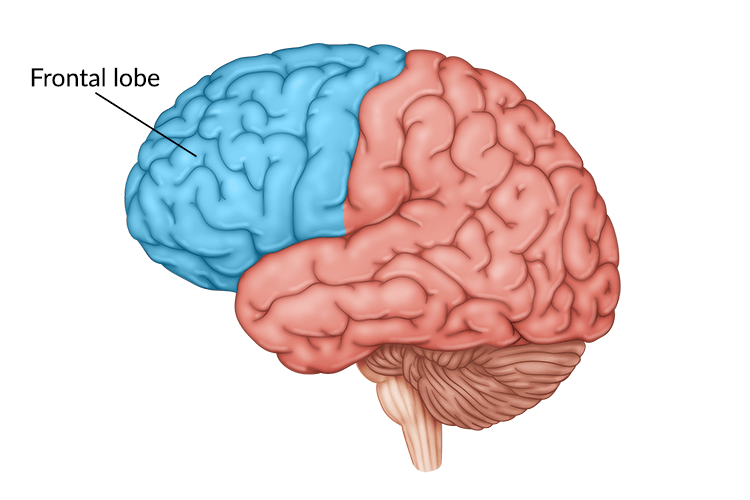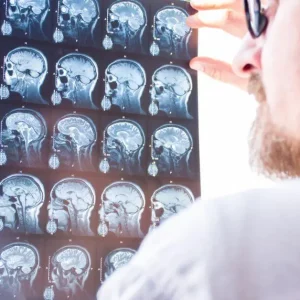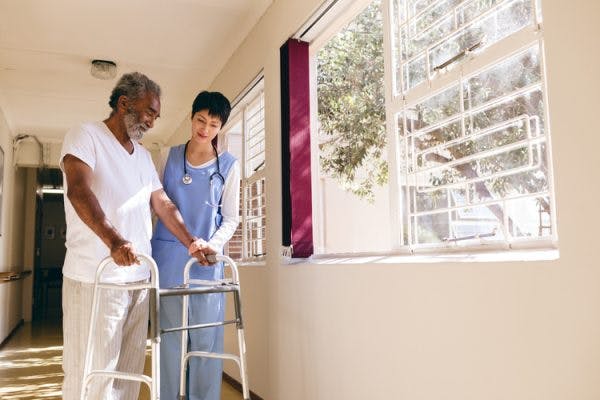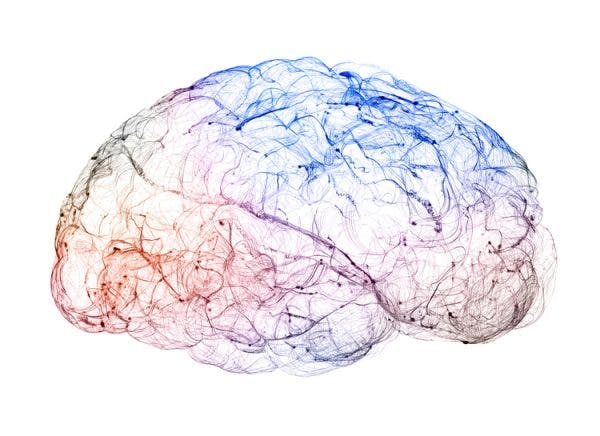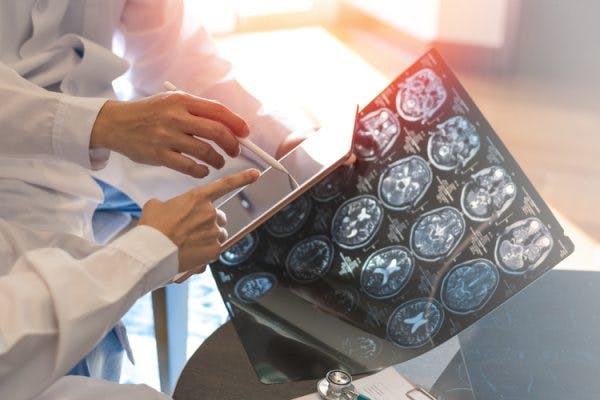The frontal lobe is the largest lobe of the brain and is responsible for higher cognitive functions. This includes language, memory, problem solving, and judgment. The frontal lobe also plays a big role in our emotional expression, personalities, and movement.
Since the frontal lobe is involved in so many cognitive, emotional, and motor processes, recovery from a frontal lobe stroke can be particularly difficult. In this article we will discuss what to expect from a frontal lobe stroke and how to promote a successful recovery.
Table of Contents
Understanding the Frontal Lobe’s Function
Located at the front of the brain, the frontal lobe makes up over one-third of the brain’s volume and helps control many important functions. For example, the frontal lobe contains the prefrontal cortex, which is the area of the brain responsible for controlling cognition, emotional processing, and decision-making. The frontal lobe also houses the motor cortex, which initiates voluntary or purposeful movement.
To help you understand the workings of the frontal lobe, let’s summarize some of its primary functions:
- Speech and language. The left half of the frontal lobe, specifically Broca’s area, helps form thoughts into verbal language. Other parts of the frontal lobe also help with language skills.
- Motor skills. The frontal lobe is home to the primary motor cortex, a region that controls muscle movement. The motor cortex directs active movements that allow you to walk, run, pick up an object, and perform any other physical movement you can think of.
- Executive functioning. The frontal lobe plays a critical role in a person’s ability to plan, make decisions, manage their needs, and multitask. It also plays a big role in attention and concentration.
- Empathy and social skills. The frontal lobe helps us empathize and understand the feelings of others. Additionally, this area of the brain is responsible for impulse control and emotional regulation.
Due to its involvement in so many critical functions, frontal lobe stroke can result in many secondary effects. It is important to talk with your neurologist about which hemisphere of the brain was affected by the frontal lobe stroke, as that can have implications for recovery.
Causes of Stroke in the Frontal Lobe
There are two main types of stroke that can affect the frontal lobe (and all other areas of the brain). First, an ischemic stroke occurs when a blood clot obstructs an artery in the brain, depriving this part of the brain of oxygen. Second and less common, a hemorrhagic stroke occurs when an artery in the brain bursts, causing bleeding in the brain.
Since the frontal lobe accounts for a large portion of the brain, the chances of a frontal lobe stroke are higher than subcortical strokes that occur deep within the brain. The frontal lobe is especially susceptible to injury if there is damage to the anterior cerebral artery, or ACA.
The entire brain, including the frontal lobe, is divided into two halves. These halves are called hemispheres and are designated as left and right. Each hemisphere of the brain controls the opposite side of the body, so the left hemisphere controls the body’s right side and vice versa.
As a result, impairments usually occur on the side of the body opposite the stroke. In other words, a right frontal lobe stroke may impair movement on the left side of the body, and a left frontal lobe stroke may impair the right side.
Secondary Effects of Frontal Lobe Stroke
The frontal lobe controls a wide array of functions, both motor and non-motor. When this area of the brain becomes damaged by the impact of a stroke, any of these functions can be disrupted.
Here are some of the most common secondary effects of frontal lobe stroke:
- Hemiparesis or hemiplegia. Hemiparesis refers to weakness of one half of the body, generally occurring on the opposite side of the stroke. Hemiplegia is even more involved, resulting in paralysis of half the body. Since the frontal lobe controls voluntary movement, motor issues are common after frontal lobe stroke.
- Speech difficulties. Speech-language impairments, such as aphasia, are particularly common after left frontal lobe stroke. This is because the left hemisphere of the frontal lobe is usually the language center of the brain. Every brain is wired a bit differently though, and no brain function is controlled solely in one hemisphere alone.
- Dysphagia. Difficulty swallowing, a condition known as dysphagia, can occur after frontal lobe stroke. Left untreated, dysphagia can lead to other complications including choking, pneumonia, or malnutrition. Following severe strokes, some patients may even require a feeding tube.
- Ataxia. Difficulty with coordinated movement (a condition known as ataxia) can occur when the frontal lobe’s control of voluntary movement is compromised. Ataxia can affect movement of the limbs, eye movements, and even speech and swallowing. When the frontal lobe sustains damage due to stroke, ataxia may be especially evident during gait (walking).
- Incontinence. When a survivor sustains damage to the frontal lobe, they may lose the ability to control their bladder or bowels (which are controlled by muscles) and experience incontinence. For survivors of frontal lobe stroke, bladder incontinence is especially prevalent,
- Impaired spatial reasoning. Since the frontal lobe controls our spatial awareness, a frontal lobe stroke may affect a patient’s ability to navigate their environment. Additionally, survivors may have significant difficulty pinpointing the location of things they see, feel, or hear.
- Vascular dementia. This refers to a loss of several important cognitive skills including impulse control, memory, and attention. It can also be associated with strange behaviors. Vascular dementia occurs when blood flow to the brain is reduced during a stroke, although it can also be a result of other neurological disorders. Vascular dementia is especially prevalent following damage to the left hemisphere and is thought to affect 25-30% of ischemic stroke survivors.
- Behavior and personality changes. Not all side effects are as extreme as dementia, but many survivors of frontal lobe stroke experience shifts in behavior. Since the frontal lobe is involved in emotional regulation, survivors may exhibit behaviors such as irritability or impulsiveness. Frontal lobe stroke can also result in global personality changes including apathy, anxiety, or decreased motivation.
- Cognitive deficits. As we discussed earlier, the frontal lobe plays a strong role in executive functioning. A stroke in this area of the brain may impair a survivor’s ability to think critically, make decisions, and manage their needs.
As you can see, there are many possible secondary effects following frontal lobe stroke because the frontal lobe controls a wide array of functions. Every stroke is unique, and every brain is wired a bit differently. Therefore, every frontal lobe stroke survivor will experience different secondary effects.
The good news is that the brain can heal itself after a frontal lobe stroke. Through hard work and intensive therapies, some (if not all) secondary effects can be minimized or improved.
How to Heal the Brain After Frontal Lobe Stroke
While the effects of frontal lobe stroke can be damaging, they may not all be permanent. In fact, the brain can reassign functions to healthy portions of the brain to help “pick up the slack” and compensate for or regain lost skills.
This process is known as neuroplasticity, and it allows patients to recover, at least partially, from the secondary effects of stroke. Through massed practice, you can activate neuroplasticity and retrain your brain to recover abilities lost after frontal lobe stroke.
To understand how neuroplasticity works, think of it as paving new roads. These new roads are the neural pathways, or connections, between your brain and the rest of your body, including your muscles. The more you practice something, the stronger and more efficient these roads become.
Repetition is how all skills are originally learned when you are young — and it’s how skills are re-learned during rehabilitation from frontal lobe stroke. The more you engage in massed practice and consistently practice skills long-term, the stronger these neural pathways become and the more your function improves. Therefore, even if you’ve suffered damage to the frontal lobe, you may still be able to regain function through dedicated rehabilitation.
How Frontal Lobe Stroke Rehabilitation Works
To regain function after frontal lobe stroke, you will need to take part in rigorous therapy and rehabilitation. Here are a few types of therapies that can promote a successful recovery from frontal lobe stroke:
- Speech therapy. If your frontal lobe stroke caused aphasia (difficulty speaking and/or understanding language) or dysphagia (swallowing difficulties), begin speech therapy exercises right away. A speech therapist can teach you how to retrain your brain and regain language skills. They can also help you improve your swallowing and recommend techniques for safe eating.
- Physical therapy. To recover muscle strength and coordination, make sure you participate in physical therapy exercises. Daily stroke exercises are the key to recovery in order to improve function and independence. By exercising the affected parts of your body, you will stimulate your brain and rekindle the neural networks that help you move.
- Occupational therapy. After a stroke, it may be difficult to perform self-care activities, also known as “activities of daily living.” Working with an occupational therapist will help you regain some of these functional skills so you can return to being more independent. Interventions provided by your OT can also help you with skills needed for doing things around your home, returning to work or school, and potentially driving.
- Cognitive-behavioral therapy. CBT helps people develop positive strategies to avoid harmful actions. It can be especially helpful for stroke victims who struggle with impulsivity. A trained therapist will be able to help you recognize triggers or negative behaviors and help you develop strategies to avoid or regulate these behaviors.
- Cognitive training exercises. This training, which is often guided by a speech therapist, can help improve memory, attention, problem-solving, and learning skills. You can do this through intensive repetition of cognitive exercises for stroke recovery.
- Positive psychology. Depression and grief are commonly experienced after stroke due to major life changes and loss of function or independence. To address this, positive psychology can help retrain the brain to experience more positive emotions. To learn more about this, check out our book Healing & Happiness After Stroke.
It is crucial to work closely with your rehab team to develop a rehabilitation plan that is unique to you. This will allow you to work toward your specific goals, regain lost function, and recover more quickly from frontal lobe stroke.
Understanding Frontal Lobe Stroke
The frontal lobe is the biggest lobe of the brain and plays a role in many different functions. Therefore, a stroke in the frontal lobe can result in a wide variety of side effects including hemiparesis or hemiplegia, cognitive deficits, ataxia, and speech-language impairments.
Fortunately, thanks to the brain’s neuroplasticity, recovery is possible. By participating in various forms of therapy, you can help rewire the brain and retrain the functions that may have been lost.
The key to recovery from frontal lobe stroke is finding therapies that fit your specific needs and goals and to prioritize consistent, repetitive practice. We hope this article helped you better understand common secondary effects following frontal lobe stroke as well as the best methods to boost recovery.

